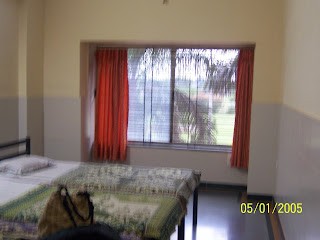 |
| Devi |
 |
| Kalaram temple |
 |
| Bajrang Bali |
We befriended a family of four from Rajasthan and a very friendly couple from Karnataka and their playful son. As unbeleivable is it may be, we squeezed into one autorickshaw and saw the rest of the temples together. This was my favourtie part in whole trip. History was staring us in the face. Panchvati, where Sita lived during exile is named after five trees surrounding the cottage which still stand. The cottage has been turned into a temple but still housed a cave where Sita was made to hide when Ravan threatened to kindap her. It's a tiny rock cave we are permitted to enter. The cave has a niche in the wall for a lamp perhaps and a marble tortoise, Lord Brahma's chosen vehicle and a Shivalinga where Sita used to pray. It was one of the most captivating sights I've ever seen. Visiting this place is a must for any connoisseur of ancient Indian history.
The chatty driver took us to Tapovan. where Laxman did penance, Triveni, the place from where Sita was abducted and the Lakshman Rekha. The Lakshman Rekha was a line Laskshman drew arounf Sita's hut enchanting it with mantra's forbidding her to venture out of it's confines for within it she would be safe. It would turn to a ring of fire if a stranger tried to tresspass but it now is a narrow stream of water.
A museum showing the life the exiled trio lived is close by and is worth visiting. Guava's are a speciality and worthy of their fame.
 |
| Triveni |
 |
| Mum at the museum with some goofy looking soldier |
We then went on a long but very pleasant drive to Trayambakeshwar, on of the Jyotirlingas. Our driver asked us to take our shoes off in the car and we had to tread on a very rocky and very dirty path to the temple. A word of caution, cameras are not allowed in the temple premises so please leave them in the vehicle or with a friendly shopkeeper. The temple was another stellar example of ancient Indian architecture. But before we reached the temple we had through wade our way through a long serpentine river of humanity. It was Poornima, the day of the full moon, auspicious to Shaivas. It took us an hour to get to the temple. After the shrine to Nandi, Shiva's bull, we entered the sanctum sanctorum of Trayambakeshwar. I ran my hand over the cold stone walls of the temple and over the marble carvings decorating them feeling connected with the sculptor, a common man who must have stood there as I did many many years ago. A door before the idol had coins hammered into it by devotees who visited before us. I saw a coin with a crown with "Empress of India" written above it reminding me of a once Victorian India. The temple has seen history being written, the rise and fall of empires and the changin landscape of the city it's in, but I doubt there has been any change in the faith it commands in the hearts of the thousands who throng to it.
 |
| Countryroads |
It was a long day. We reached the hotel at midnight.















